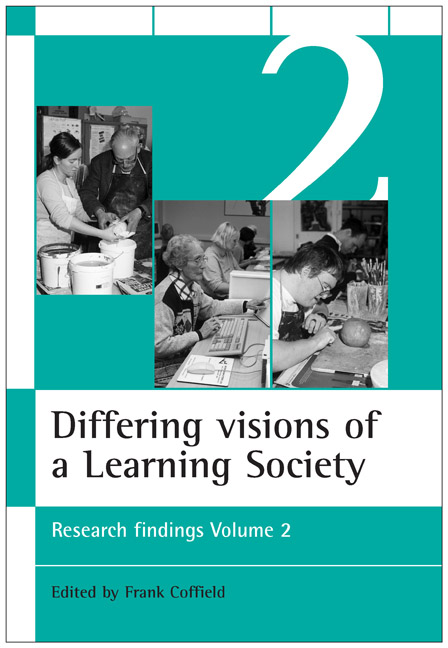Book contents
- Frontmatter
- Contents
- Notes on contributors
- Dedication
- The three stages of lifelong learning: romance, evidence and implementation
- one The meaning of the Learning Society for adults with learning difficulties: bold rhetoric and limited opportunities
- two Networks, norms and trust: explaining patterns of lifelong learning in Scotland and Northern Ireland
- three Learning culture, learning age, learning society: turning aspirations into reality?
- four Teaching and learning in higher education: issues of innovation
- five Participating in the Learning Society: history, place and biography
- six Skills in the British workplace
- Index
- The Learning Society series
six - Skills in the British workplace
Published online by Cambridge University Press: 05 July 2022
- Frontmatter
- Contents
- Notes on contributors
- Dedication
- The three stages of lifelong learning: romance, evidence and implementation
- one The meaning of the Learning Society for adults with learning difficulties: bold rhetoric and limited opportunities
- two Networks, norms and trust: explaining patterns of lifelong learning in Scotland and Northern Ireland
- three Learning culture, learning age, learning society: turning aspirations into reality?
- four Teaching and learning in higher education: issues of innovation
- five Participating in the Learning Society: history, place and biography
- six Skills in the British workplace
- Index
- The Learning Society series
Summary
Context
Although the study of education has long been recognised to have an economic aspect, in that education is in part an investment for future monetary gain, it was not until around the middle of the 1980s that the pivotal role of education and training policies as economic policies began to be widely canvassed. Much cited studies by Finegold and Soskice (1988), Reich (1988), Marshall and Tucker (1992) and others highlighted the salience of achieving a highly skilled workforce in an increasingly global economic environment. The British education system was diagnosed by many as failing the economy, except perhaps at the highest level of university participation. Deficiencies in intermediate skills were identified (eg Steedman and Wagner, 1987; Daly et al, 1985), and in recent years the alarmingly large proportion of British workers lacking basic skills has been castigated (Murray and Steedman, 1998).
Following recognition of this problem, many policy changes have been enacted. To highlight just a few, we may cite the introduction of the National Curriculum in 1988, the switch from O levels to GCSEs, the setting up of employer-dominated Training and Enterprise Councils (TECs) for the delivery of work-based training, the attempt to simplify the system of vocational qualifications via the NVQ system and, at the enterprise level, the introduction of Investors in People.
Coincident with these changes, although only partly as a result of policy, there has been a radical shift in individuals’ attitudes to education, as reflected in sharply rising participation rates beyond the compulsory school leaving age. Whereas in 1985 only 67% of 16 and 17 year olds in England participated in some form of education or training, by 1995 that figure had risen to 83%, with all of this growth being due to an increase in the proportion who remained in full-time education. Since 1979 student numbers have doubled and the proportion entering higher education has risen from one in eight in 1979 to almost one in three in 1995 (DfEE, 1997). Work-related training participation has changed also, in that the proportion of employees taking part in training has risen from around 11% in 1985 to 15% in 1998. The total volume of training – as measured by time spent in training – has probably not changed much, because courses have become shorter (Felstead et al, 1999b).
- Type
- Chapter
- Information
- Differing visions of a Learning Society Vol 2Research Findings, pp. 193 - 228Publisher: Bristol University PressPrint publication year: 2000
- 1
- Cited by



